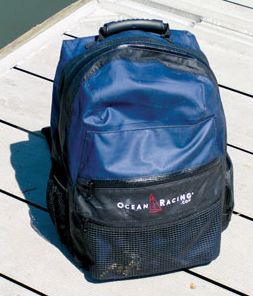Italian sailing gear-maker Slam has recently come out with a new laptop backpack, a water-resistant tote for that all-important lifeline to global communications and keeper of all things digital. Like the Oceanracing.com backpack that we reviewed in the January 2007 issue, the Slam bag is specifically designed to carry a laptop in the marine environment.
The Slam backpack has two front-accessed, zippered pockets, and one zippered, front mesh pocket. There are also mesh pockets on the sides.

What sets the Slam bag apart from the Oceanracing.com pack, design wise, is its roll-top closure. Where the Oceanracing.com bag has a zipper closure for the main compartment, the Slam bag has a webbing-rimmed opening with plastic clips at either end. This design is standard on most drybags used for kayaking, diving, and other watersports. The top is rolled down until the bag is as compact as it can get, and the plastic clips are fastened to their corresponding mates mounted on the bags front.
The Slam bag is made of a soft polyurethane-coated nylon, and the interior of the main compartment is also coated with a film for better water resistance. Unlike PVC coatings, these are all non-toxic. The zippers are all coated, but like the Oceanracing.com, the Slams metal zipper concerned testers.
Padded, adjustable shoulder straps ensure a comfortable fit on just about any torso, and the back of the bag is also padded. The main compartments interior has an organized stowage pocket. A thinly padded cloth sleeve protects the laptop and is attached via thick strips of Velcro. There are small, plastic D-rings sewn to the shoulder straps and daisy-chain style webbing to accommodate clip-on gear.
The Slam bags style and features are impressive, but testers found its performance on par with other drybags we tested. We placed dry towels in each of the three non-mesh compartments, and then tested the bag against simulated spray, rain, and submersion. We also tested whether it would allow water in if it was left floating for a while.

We sprayed it with a garden hose at full force, and found no water in any of the sealed compartments. Loaded with the towels and 20 pounds of groceries, the bag was left floating in a freshwater pool for 10 minutes. The bag showed no signs of leaking in the main compartment, but the smaller pockets all had some water in them.
Neither Slam nor Oceanracing.com claim that their bags are submersible, so swimming with your laptop is still not an option. The Slam bag was immersed in 3 feet of water for 3 minutes. A steady flow of tiny bubbles came from several points of the bag-mostly seams-indicating that air was leaking out, and eventually water could seep in, through these same areas. When the bag was pulled from the pool bottom, the main compartments towel was thoroughly soaked.
After testing, we found a pinhole in the bag. Its cause remains a mystery, but it likely occurred when the bag was loaded with a laptop and other gear during field testing. Later tests found that even a ball-point pin could puncture the fabric.
Conclusion
The Slam is a well-made bag that will keep your gear dry in moderate rain, during a wet dinghy ride, or a quick drop in the drink. It performed as well as the Oceanracing.com backpack, is more comfortable, and has more bells and whistles. However, the fabric can be punctured and can develop holes during regular use. Longterm testing of the Oceanracing.com bag has shown it to be durable.
Because of the mysterious pinhole, our tests were inconclusive as to which closure method keeps out water the best-coated zipper vs. rolled top. We like the Oceanracing.coms laptop compartment design: a separate, coated, sealed inner compartment that houses a laptop in a neoprene sleeve for added protection. At $109 (www.team1newport.com), the Slam is $50 less than the Oceanracing.com pack and in the same range as other gear drybags. If you want an all-purpose bag that is light and comfortable, and will keep your gear dry on some very wet dinghy rides, both bags fit the bill.



































